Symposiums
Speakers:
Shihab Shamma, Univ. of Maryland on “Learning Speech Production and Perception with Sensorimotor Interactions”
Vasant Honavar, Professor, Pennsylvania State University on “Learning Predictive Models from High Dimensional Longitudinal Data”
Anand Louis, Assistant Professor, CSA on “Algorithms with Fairness Guarantees”
Siddharth Barman, Associate Professor, CSA on “Algorithms for Fairness and Collective Welfare”
Sundeep Prabhakar Chepuri, Assistant Professor, ECE on “Discovering Structured Graphs from Multi-domain Data”
Anirban Chakraborthy, Assistant Professor, CDS on “Learning Across Modalities in Computer Vision Applications”
Chirag Jain, Assistant Professor, CDS on “Algorithms to Optimise Reference Pangenome Graphs for a Population”
Arkaparva Basu, Assistant Professor, CSA on “Enhancing GPU Architecture for the Deployment in Cloud”
The symposium was conducted in virtual mode, on the 30th of July, 2021. The talks were presented virtually. Prof. Sridharan Devarajan (Centre for Neuroscience, IISc) and Prof. Prasanta Kumar Ghosh (Department of Electrical Engineering, IISc) organized the event.
Prof. Narahari (Department of CSA, IISc) welcomed the speakers and the audience. The symposium had three sessions. The first session, scheduled between 03.15 pm to 04.35 pm, chaired by Dr. Hardik Pandya (Assistant Professor, Department of Electronic Systems Engineering, IISc) had the following four talks:
- Dr. Anand Louis (Department of Computer Science and Automation, IISc) presented the latest research in “Algorithms with Fairness Guarantees”.
- Prof. Siddharth Barman (Department of Computer Science and Automation, IISc) described research in his lab to understand “Algorithms for Fairness and Collective Welfare”.
- Dr. Sundeep Prabhakar Chepuri (Department of Electrical Communication Engineering, IISc) spoke about “Discovering Structured Graphs from Multi-domain Data”. Specifically, and discussed about having good quality graphs for signal processing and machine learning tasks.
- Dr. Anirban Chakraborthy (Department of Computational and Data Sciences, IISc) presented on “Learning Across Modalities in Computer Vision Applications” and described on Text based Person Search via Attribute-aided Matching, Sketch guided object Localization in Natural Images and From Strings to Things: Knowledge enabled Text-VQA that can read and reason.
The second session, scheduled between 05:05 pm to 05:40 pm, chaired ”by Dr. Chetan Singh Thakur (Assistant Professor, Department of Electronic Systems Engineering, IISc) had the following two talks:
- Dr. Chirag Jain (Department of Computational and Data Sciences, IISc) delivered the first talk of the session on “Algorithms to Optimise Reference Pangenome Graphs for a Population ”.
- Dr. Arkaparva Basu (Department of Computer Science and Automation, IISc) highlighted on “Enhancing GPU Architecture for the Deployment in Cloud”. He emphasized on GPU as a primary compute platform for the data-driven era, path to democratizing GPU compute is via the cloud, need for cloud-friendly design for GPUs and the work addresses resource underutilization and unfairness.
The final session, scheduled between 06:00 pm to 07:00pm of the symposium, was delivered by the Chair Professors of Pratiksha Trust and was hosted by Prof. Sridharan Devarajan (Assistant Professor, Centre for Neuroscience, IISc).
- The first talk was delivered by Prof. Vasant Honavar (Pennsylvania State University) on “Learning Predictive Models from High Dimensional Longitudinal Data”. Prof. Vasant discussed unsupervised representation learning from multivariate functional data. FAE, a novel autoencoder neural network that directly copes with functional data. Development of Functional gradient-based optimization algorithm and functional autoencoder.
- The final talk of the symposium was presented by Prof. Shihab Shamma (University of Maryland). Prof. Shihab gave an overview of Imagining Music and Auditory Motor Associations, Activations of Imagining vs. Hearing Music, and Abstracting the Auditory-Motor Interactions as the Mirror Network.
The symposium concluded with a vote of thanks by Dr. Sridharan Devarajan. The symposium provided a distinctive opportunity for the speakers and participants to come together to share and learn about current developments in these emerging fields. The virtual platform enabled engagement between participants and speakers by having interactive sessions after every talk.
The symposium was conducted in virtual mode, on the 2nd of July, 2021. The talks were presented virtually. Prof. Prasanta Kumar Ghosh (Department of Electrical Engineering, IISc) and Prof. Sridharan Devarajan (Centre for Neuroscience, IISc) organized the event.
Prof. Narahari (Department of CSA, IISc) welcomed the speakers and the audience. Prof. PS Sastry (Department of EE, IISc) gave a gist of the program and an introduction about Pratiksha Trust. The symposium was divided into two sessions.
Session 1: 04 talks
Schedule: 02.50pm to 04.10pm
Chair: Dr. Anirban Chakrabarty, Department of Computational Data Sciences, IISc
“Predicting the naturalness of artificially generated videos”
Rajiv Soundararajan, Assistant Professor, ECE, IISc
SP Arun, Associate Professor, CNS, IISc
“Fabricating Novel Micro-Electrode Cannula Arrays to Design Neuroprotective Therapies for Acute Stroke and Epilepsy”
Hardik Pandya, Assistant Professor,ESE, IISc
Siddharth Jhunjhunwala, Assistant Professor, BSSE,IISc
Mahesh Jayachandra, Facility Technology Manager, BSSE, IISc
“Deep Neural Networks For 3D Understanding”
Venkatesh Babu, Professor, CDS, IISc
Vijay Natarajan, Professor,CSA, IISc
“HPC Framework for large scale study of Brain Networks”
Ambedkar Dukkipati, Professor, CSA, IISc
Sathish Vadhiyar, Associate Professor, CDS, IISc
Session 2: 04 talks
Schedule: 04:30pm to 06:00pm
Chair: Dr. Sundeep Prabhakar Chepuri, Department of Electrical Communication Engineering, IISc
“Time-Based Sampling of FRI Signals”
Chandra Sekhar Seelamantula, Professor, EE, IISc
Chetan Singh Thakur, Assistant Professor, ESE, IISc
“Characterizing spatiotemporal transformations between facial myoelectric signals and articulatory behavior during regular speech, silent speech and silent reading”
Prasanta Kumar Ghosh, Associate Professor,EE, IISc;
Aditya Murthy, Professor, CNS, IISc
“Rapid, large-scale connectome estimation for mapping structure-function relationships in healthy and diseased brains”
Sridharan Devarajan, Assistant Professor, CNS & CSA, IISc;
Partha Pratim Talukdar, Associate Professor, CDS & CSA, IISc
“Whole genome sequencing in human cohort studies informs the genetic architecture of complex phenotypes”
Bratati Kahali, Assistant Professor, CBR, IISc
The symposium concluded with a vote of thanks by Dr. Sridharan Devarajan and facilitated lively interactions among the speakers and participants by having interactive sessions after every talk.
October 18, 2019
3PM-5PM
Golden Jubilee Hall
Department of ECE
Indian Institute of Science, Bangalore
ABOUT
The Brain, Computation, and Data Science initiative, set up in June 2015, sprung out of the generous endowment provided by Mr. Kris Gopalakrishnan and Mrs. Sudha Gopalakrishnan, founders of the Pratiksha Trust, Bangalore. The mission of this initiative is to foster intense research collaboration leading to capacity building, ecosystem creation, and high impact research outcomes in brain, computation, and data science in IISc and India. The participating departments and centres of IISc include: Computer Science and Automation, Computational and Data Sciences, Centre for Neuroscience, Electrical Communication Engineering, Electrical Engineering, Electronic Systems Engineering, Mathematics, and Molecular Biophysics.
Award of Pratiksha Trust Young Investigator Positions to Assistant Professors is one of several initiatives by the Pratiksha Trust. This symposium will feature talks by all the Pratiksha Trust Young Investigator awardees.
SPEAKERS
Dr. Sridharan Devarajan, Centre for Neuroscience, IISc
Dr. Sriram Ganapathy, Department of EE, IISc
Dr. Chetan Singh Thakur, Department of ESE, IISc
Dr. Prasanta Kumar Ghosh, Department of EE, IISc
Dr. Siddharth Barman, Department of CSA, IISc
Dr. Anirban Chakraborty, Department of CDS, IISc
Dr. Sundeep Prabhakar Chepuri, Department of ECE, IISc
Dr. Anand Louis, Department of CSA, IISc
Please look up for more details about the symposium:
Pratiksha Trust Symposium on BCD
Organized by
Division of EECS, Indian Institute of Science, and
Brain, Computation, and Data Group
Indian Institute of Science
https://brain-computation.iisc.ac.in/
Symposium on Neuromorphic Cognitive Computing
Number of Participants: 202
Speakers
Shihab Shamma, Univ. of Maryland on “Neural networks and the representation of categories in the brain”
Sridharan Devarajan, IISc, Bengaluru on “Neuromorphic models of brain oscillations”
S.P. Arun, IISc, Bengaluru on “Cracking the code for visual objects”
Andre van Schaik, Western Sydney Univ. on “Neuromorphic event-based image processing”
Raghavendra Singh, IBM on “Cognition and computation”
Ralph Etienne-Cummings, The Johns Hopkins University on “I, Robot: Blurring the lines between mind, body and robotics”
Summary of the Symposium:
The Pratiksha Trust hosted a one-day”Neuromorphic Cognitive Computing Symposium” at IISc,Bengaluru. The purpose of this symposium was to promote an interactive discussion and knowledge of the latest research in the field of neuromorphic computing. Neuromorphic computing is an interdisciplinary research domain that draws inspiration from multiple disciplines such as biology, engineering, and mathematics. The objective of the workshop was to bring people from such multiple disciplines on a single platform and discuss potential research and collaborations in this exciting area. Participation in the workshop was overwhelming;202 people from various research backgrounds, including participants from industry, attended the workshop. The symposium provided an oppurtunity to discuss key initiatives taken by The Pratiksha Trust to support research in IISc to promote neuromorphic engineering in India. The demo session at the symposium was enormously successful, as participants directly interacted with several neuromorphic systems and were amazed to see how these systems outperform the conventional technology. Neuromorphic camera and real-time cochlea model are some examples of the neuromorphic systems that were demonstrated.
The symposium featured several interesting talks by world leaders in neuromorphic engineering (Prof. Shihab Shamma, Prof. Andre van Schaik, and Prof.Ralph Etienne-Cummings) and one by a speaker from the industry. These talks covered the breadth of research ranging from neuroscience to engineering. Below is a brief summary of each of the talks:
- “Neural networks and the representation of categories in the brain”: Prof.Shihab Shamma from the University of Maryland discussed the principle of temporal coherence, which postulates that a signal is perceived as emitted from a single source only when all of its features are temporally modulated coherently, causing them to bind perceptually.
- “Neuromorphic event-based image processing”:Prof.Andre van Schaik from The MARCS Research Institute, Western Sydney University discussed the event-based neuromorphic camera and its applications to ‘micro’ air vehicles (MAVs). His research provided convincing proof that the asynchronous nature of the neuromorphic camera removes the need for any global timing systems, such as the global shutter used in conventional cameras. As a result, these cameras do not suffer from the motion blur and the saturation effects suffered by conventional cameras.
- “I, Robot:Blurring the lines between mind, body and robotics”:Prof.Ralph Etienne-Cummings from The Johns Hopkins University presented an overview of the field of neuromorphic engineering and disussed specific applications. His work showed that future brain-machine interfaces (BMI) will not only be used to infer the host’s intentions from brain activities or to rpovide the host with extrinsic information (e.g. sensory feedback), but may provide enhancements and/or replacement of parts of the brain itself. He assert that such BMI devices will not be truly realized until the electronics “speak the same language” as the biological brain. Henace, the complete system must be neuromorphic, implying that it must replace the form and function of the brain.
- “Cognition and computation”:This talk, presented by Dr. Raghavendra Singh from IBM Inc. India, focused on building computational models to enable cognition in mahines. He discussed the biological plausibility pf current deep learning models, implimentation of such models on low power neuromorphic chips, and their application to the enticing world of fashion.
- “Robust working memory through gamma oscillations”:Dr.Sridharan Devarajan from the Indian Institute of Science, Bengaluru, described an in-silico model network of excitatory and inhibitory neurons that seeks to emulate robust maintenance of information in working memory. Due to the wide heterogeneity in the firing propeties of in-silico neurons, persistent activity within this network does not remain stable but rather drifts to the local neighbourhood of the most excitable neurons. He demonstrated how inducing synchronous gamma-band oscillations within this network transiently homogenizes the firing properties of neurons, thereby enabling the robust and stable maintenance of persistent activity within this network.
- “Cracking the code for visual objects”: Dr.S P Arun from the Indian Institute of Science, Bengaluru, presented recent findings from his lab elucidating the code for visual objects using both behavioral experiments in humans and single neuron recordings from monkeys. This code operates according to systematic rules, incorporates knowledge abouth the world, enable simple decoding of relevant information and is systematically different from most computer vision algorithms.
- Demo and posters: This session was the most successful part of the event. Various labs from IISc presented demos and posters covering the broad range of topics from neuroscience to electronics engineering.
Images of Symposium:
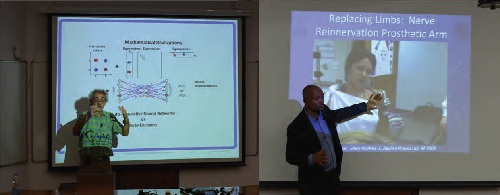
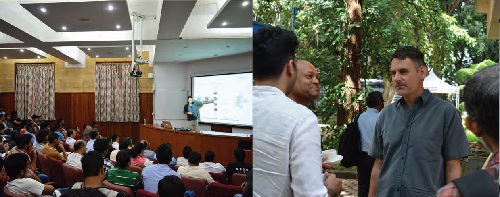
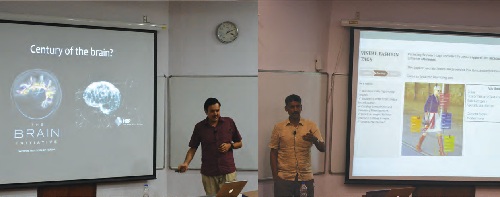
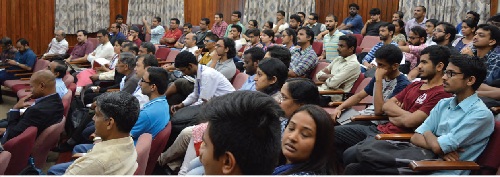
Workshops
Date: 30th June-4 th July, 2025
Location: Faculty Hall, Indian Institute of Science
Sponsored by: Pratiksha Trust and Indian Institute of Science
The primary aim of this biennial workshop is to promote interdisciplinary research in the broad area of neuroscience and artificial intelligence in India and to promote synergistic interactions among neurobiologists and engineers. The workshop would allow young researchers to understand the diverse themes of research and appreciate the close relationships between these apparently distinct themes. The overarching theme of BCL5 workshop is “Brain Co-Processors”. This is part of a bigger “Moonshot” project, details of which can be found here: https://brain-computation.iisc.ac.in/moonshot-project/
The program consisted of five one-day thematic modules: Vision (June 30), Motor and Cognition (July 1), Clinical (July 2), NeuroEngineering (July 3), and a newly introduced module—NeuroTech (July 4). The NeuroTech module featured startups and companies that showcased their products and innovations in the neurotechnology space.
This workshop is funded by a generous endowment from the Pratiksha Trust, which has been significantly promoting fundamental and translational neuroscience research within the country through the establishment of research centres and chair professorships at the Indian Institutes of Science (Bengaluru) and Indian Institute of Technology Madras (Chennai).
More details about BCL5 are available: https://bcl.iisc.ac.in/bcl5/
Date: June 15 – June 21, 2024
Location: Centre for Neuroscience, Indian Institute of Science, Bangalore
Sponsored by: Pratiksha Trust
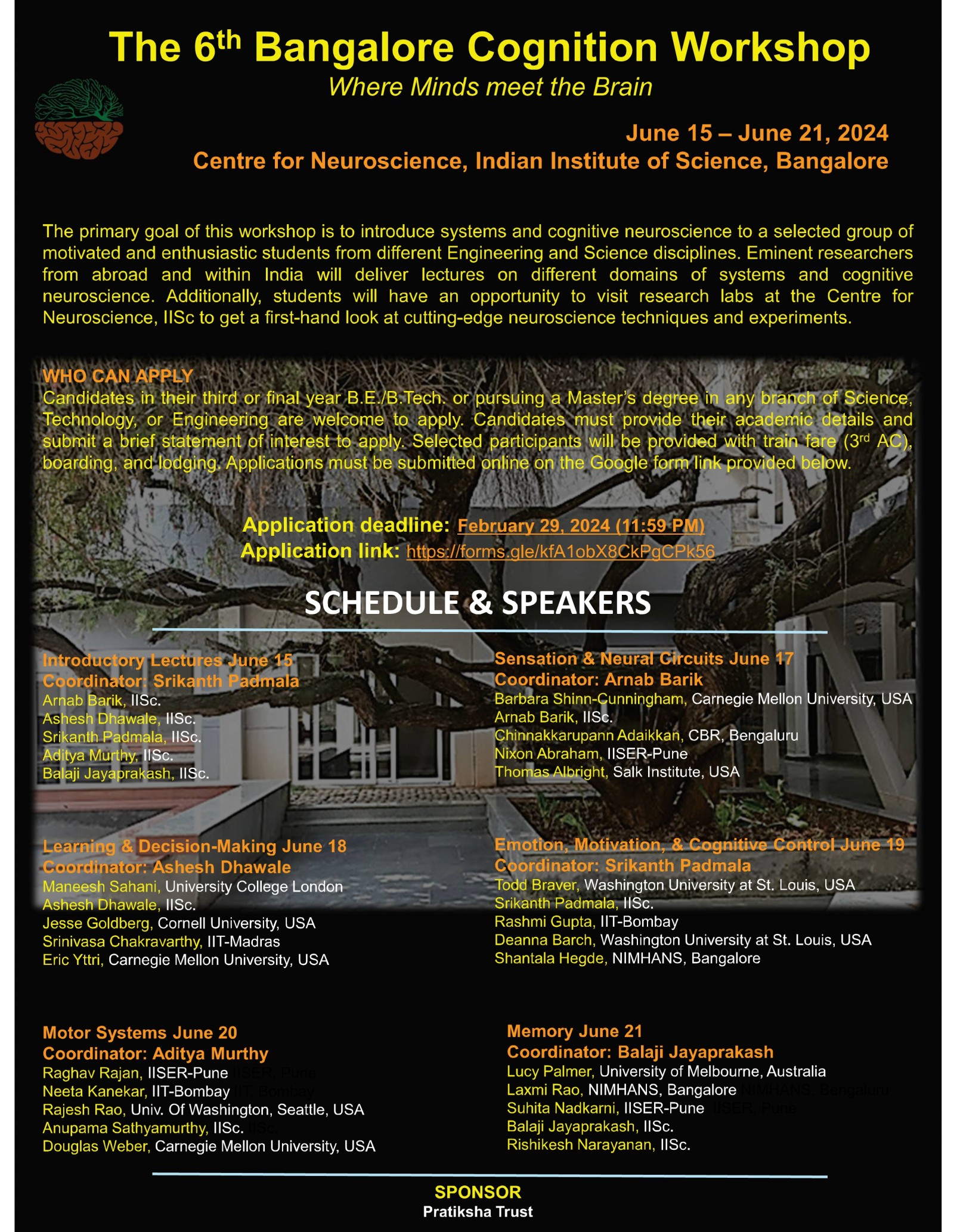
Date: January 9-13 2023
Location: Faculty Hall, Indian Institute of Science, Bangalore
Sponsored by: Pratiksha Trust and Indian Institute of Science
Computational approaches to understanding brain function form an important and growing area of interdisciplinary research. These approaches and associated techniques have acted as a melting pot for researchers from disparate disciplines to come together and address one of the grandest challenges of the 21st century. The grandness of the challenge and the requirement on diverse forms of expertise has deemed that such endeavors require synergistic interactions among neurobiologists and computer scientists. Over the past decade or two, neurobiologists have made significant conceptual advances in our understanding of the brain through technical breakthroughs that have yielded unprecedented opportunities to gather large-scale structural and functional data. On the other hand, over the same period, computer scientists have developed exceptional tools to address questions in machine learning and data analytics, tools that are not only helpful in emulating brain function, but also are radically transforming many applications in information and communication technologies. This workshop on Brain Computation and Learning is aimed at creating this useful dialogue between neurobiologists and computer scientists and educating research students of each area with relevant topics of the other.
A prominent goal of this workshop is to promote synergistic interactions among neurobiologists and computer scientists. The workshop would allow young researchers to understand the diverse themes of research and appreciate the close relationships between these apparently distinct themes.
This workshop is funded by a generous endowment from the Pratiksha Trust, which has been significantly promoting fundamental and translational neuroscience research within the country through the establishment of research centres and chair professorships at the Indian Institutes of Science (Bangalore) and Technology (Chennai).
Location: Faculty Hall, Indian Institute of Science, Bangalore
Sponsored by Pratiksha Trust and Indian Institute of Science
Computational approaches to understanding brain function form an important and growing area of interdisciplinary research. These approaches and associated techniques have acted as a melting pot for researchers from disparate disciplines to come together and address one of the grandest challenges of the 21st century. The grandness of the challenge and the requirement on diverse forms of expertise has deemed that such endeavors require synergistic interactions among neurobiologists and computer scientists. Over the past decade or two, neurobiologists have made significant conceptual advances in our understanding of the brain through technical breakthroughs that have yielded unprecedented opportunities to gather large-scale structural and functional data. On the other hand, over the same period, computer scientists have developed exceptional tools to address questions in machine learning and data analytics, tools that are not only helpful in emulating brain function, but also are radically transforming many applications in information and communication technologies. This workshop on Brain Computation and Learning is aimed at creating this useful dialogue between neurobiologists and computer scientists and educating research students of each area with relevant topics of the other.
A prominent goal of this workshop is to promote synergistic interactions among neurobiologists and computer scientists. The workshop would allow young researchers to understand the diverse themes of research and appreciate the close relationships between these apparently distinct themes.
This workshop is funded by a generous endowment from the Pratiksha Trust, which has been significantly promoting fundamental and translational neuroscience research within the country through the establishment of research centres and chair professorships at the Indian Institutes of Science (Bangalore) and Technology (Chennai).
2019 will mark the golden jubilee of Department of Computer Science and Automation at IISc. To recognize this milestone, the department is organizing a workshop on theoretical computer science coinciding with the visit of Prof. Christos Papadimitriou to the department in January 2019.
Second Workshop on Brain, Computation, and Learning
Organizing Committee:
Sridharan Devarajan, Ambedkar Dukkipati, Sriram Ganapathy, Y. Narahari, Rishikesh Narayanan, P S Sastry, Chandra Sekhar Seelamantula and Chetan Singh Thakur
Invited Speakers:
Shantanu Chakrabartty, Washington University St. Louis
Jonathan Fritz, ISR, University of Maryland
Vasant Honavar, PennState
Mark Liberman, University of Pennsylvania
Mayank R. Mehta, University of California, Los Angeles
Samuel Norman-Haignere,École Normal Supérieure
Christos H. Papadimitriou,University of California, Berkeley
Maneesh Sahani,University College London
Andre Van Schaik,Western Sydney University
Shihab Shamma,University of Maryland
Patrick van der Smagt, AI Research at Volkswagen Group
Shalabh Bhatnagar, IISc, Bengaluru
Srinivasa Chakravarthy V, IIT Madras
Sumantra Chattarji,NCBS
Sriram Ganapathy, IISc, Bengaluru
Joby Joseph, University of Hyderabad
Ravi Kannan,Microsoft Research Lab – India
Aditya Murthy, IISc, Bengaluru
Supratim Ray, IISc, Bengaluru
Rajesh Sundaresan, IISc, Bengaluru
Prasanta Kumar Ghosh, IISc, Bengaluru
More Information:
First Workshop on Brain, Computation, and Learning
Organizing Committee:
S.P. Arun, Arnab Bhattacharyya, Rishikesh Narayanan, P.S. Sastry, Chandra Sekhar Seelamantula, Shihab Shamma, Partha Talukdar Number of participants: 250
Invited Speakers:
Upinder S. Bhalla, NCBS
Hynek Hermansky, Johns Hopkins
Vasant Honavar, PennState
Stephane Mallat, Ecole Polytechnic
Jawahar C. V, IIIT Hyderbad
Patrick Kanold, Univ. of Maryland
Nima Mesgarani, Columbia University
Pratik Mutha, IIT Gandhinagar
Balaraman Ravindran, IIT Madras
Maneesh Sahani, University College London
Christoph Schreiner, UCSF Medical Center
Shihab Shamma, Univ. of Maryland
S.P. Arun, IISc, Bengaluru
R. Venkatesh Babu, IISc, Bengaluru
Arnab Bhattacharyya, IISc, Bengaluru
Sridharan Devarajan, IISc, Bengaluru
Ambedkar Dukkipati, IISc, Bengaluru
Rishikesh Narayanan, IISc, Bengaluru
Chandra Sekhar Seelamantula, IISc, Bengaluru
Sujit Kumar Sikdar, IISc, Bengaluru
Partha Pratim Talukdar, IISc, Bengaluru
Summary:
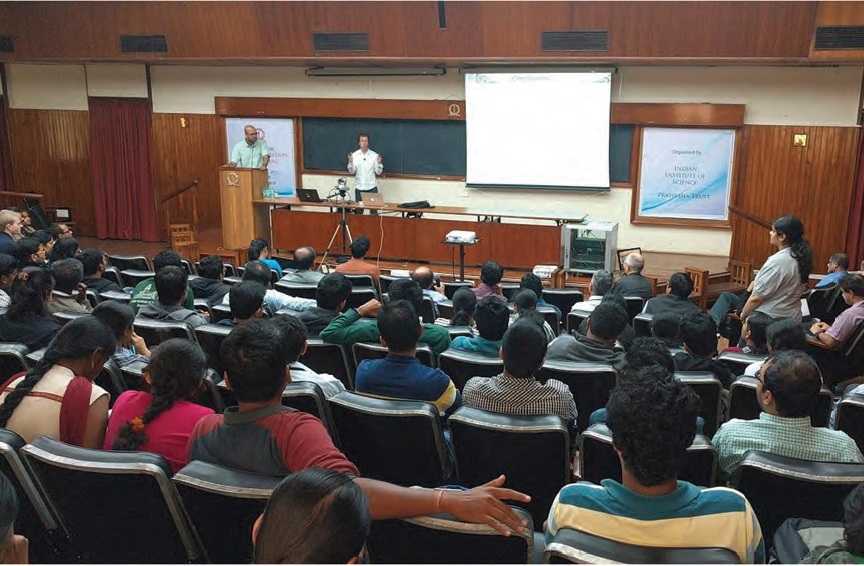
Computational approaches to understanding brain function constitute an important and groeing area of interdisciplinary research. These approaches and associated techniques have acted as melting pot for researchers from disparate disciplines to come together and address one of the grandest challenge of the 21st century, namely, understanding brain function. The grandness challenge and the requirement on diverse forms of expertise has deemed that such endeavors require synergistic interactions among neurobiologists and computer scientists. Over the past decade or two, nuerobiologists have made significant conceptual advances in our understanding of the brain through technical breakthroughs that have yieldded unprecedented oppurtunities to gather large-scale structural and functional data. On the other hand, over the same period, computer scientists have developed exceptional tools to address questions in machine learning and data analyctics, tools that are not only helpful in emulating brain function, but also are radically transforming many applications in information and communication technologies.
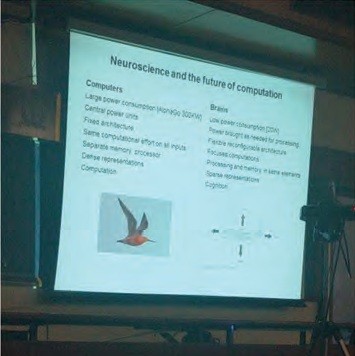
To benefit from such synergistic interactions among neurobiologists and computer scientists and educating research of each area with relevant topics and concept of the other. The workshop had talks and tutorials from prominent researchers from all over the world.
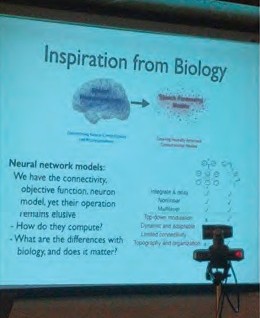
About two hundred students (selected from over 400 applicants) from all over India attended the workshop. In addition, about twenty faculty members from different institutions in India also participated in the workshop. Due to the generous funding from Pratiksha trust, all the participants were provided with free accommodation and some minimal support towards travel. The workshop provided an oppurtunity for young researchers to understand the diverse themes of brain research and to appreciate the close relationships that are developing between neuroscience and computer science. From the feedback recieved from the participants, most of them felt that they benefitted a lot from the workshop. Many particpants requested IISc to conduct these workshops every year.
Prof. Shihab Shamma, Prof. Patrick Kanold and Prof. Maneesh Sahani visited IISc in May of 2016 under the Mahabala Chair Professorship in Neuromorphic computing. As part of their visit, a one-day workshop on “Perception: Neurons and Models†was organized to discuss the latest advances at the interface of computational and experimental neuroscience, with a specific focus on auditory perception. The workshop was conducted on May 5, 2016 at the Golden Jubilee Hall at the Department of Electronics and Communication Engineering (ECE) at IISc. The organizers included Prof. Y. Narahari (Department of Computer Science and Automation), Prof. Sriram Ganapathy (Department of Electrical Engineering) and Prof. Sridharan Devarajan (Centre for Neuroscience), assisted by administrative support from the Office of the Divisional Chairmen.
Prof. Narahari welcomed the speakers and inaugurated the workshop. The workshop was divided into two sessions. The first morning session (from 9am-11am) was chaired by Prof. Aditya Murthy, Chairperson of the Centre for Neuroscience at IISc. In the first talk of the morning session Dr. Shihab Shamma (University of Maryland) presented latest research in “Cognitive control of auditory perceptionâ€. In his talk, Dr. Shamma highlighted the importance of the fact that auditory perception, rather than being a passive process, actively depends on cognitive states, such as attention. He described how his lab has applied electrophysiological recordings in ferrets and EEG recordings in humans to understand the neural code for auditory perception. In the second talk, Dr. Patrick Kanold (University of Maryland) described research in his lab to understand “Wiring and plasticity of the developing auditory cortex†using state-of-the-art experimental research tools, including in-vivo two photon imaging and stimulation, as well as in-vitro imaging and electrophysiology. In the third talk of the morning session, Dr. Maneesh Sahani (University College London) spoke about how priors beliefs influence perception in a talk titled “Perceiving is believing: Bayesian inference in unexpected placesâ€. Specifically, he discussed novel models developed by his group for the perception of time intervals, a key feature encoded by auditory neurons.
The second session of the morning (11:20am-1:100pm) was chaired by Prof. Chandrasekhar Seelamantula, Associate Professor at the Department of Electrical Engineering, IISc. Dr. T. V. Sreenivas (Department of Electronics and Communication Engineering) delivered the first talk of the session on “Time varying signal perception and pitch timbre interactionâ€. In his talk, Dr. Sreenivas highlighted behavioral psychophysics and signal processing approaches for modeling non-stationary features in speech sounds. The final talk of the workshop was delivered by Dr. Sriram Ganapathy on “Deep learning for speech processingâ€. Dr. Sriram gave an introductory overview of emerging deep learning approaches and highlighted their computational advantages and pitfalls. He also discussed cutting-edge applications of deep learning for automated identification of spoken words and sentences. The workshop concluded with a vote of thanks by Dr. Sridharan Devarajan.
The workshop provided a unique opportunity for the speakers to engage a diverse audience comprising engineers, biologists and neuroscientists. Over 100 people registered for the workshop, and the participants included undergraduate, graduate students and faculty both from within IISc, as well as from various external colleges and institutes, including IIT Madras, Anna University, PES Institute of Technology, NIMHANS, and M.S. Ramaiah Medical College.
Courses
Compact Course on MRI Physics
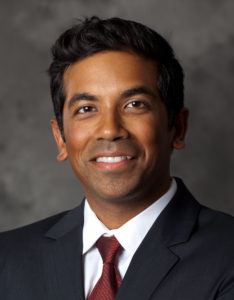
Professor Krishna Nayak
University of Southern California, USA
Krishna Nayak is a Professor of Electrical Engineering in the University of Southern California, USA, with joint appointments in Radiology and Biomedical Engineering. Prof. Nayak received a PhD in Electrical Engineering from Stanford University in 2001. His research expertise and interests are in Magnetic Resonance Imaging; MRI pulse sequence design; MRI reconstruction; MRI artifact correction; Real-time imaging; Application of MRI to the assessment of cardiovascular disease and obesity; Signal and image processing. He directs the Magnetic Resonance Engineering Laboratory whose research mission is to develop and clinically translate novel magnetic resonance imaging (MRI) technology.
Prof.Krishna Nayak visited IISc from Nov 21 – Dec 25, 2017. He delivered 5 reserach seminars on Real-Time MRI and related topics at IISc and to Bengaluru-area professional interest groups. He also taught a weeklong short-course on MRI Physics that was attended by about 45 faculty and students. He had interacions with Prof.Phaneendra Yalavarty(CDS) and his group, and also met with several other faculty including Prof.Prasanta Ghosh(EE), Partha Talukdar (CDS), PS Sastry(EE), Anil Kumar (NMR center), and Sridharan Devarajan(CNS).
Summary of the Course on MRI Physics:
The course covered the basics of MR Physics and MR image reconstruction with a hands-on homework session following each module. The homework sessions utilised MATLAB and each participant carried a laptop to complete the hand-on part. The course was designed for early reserachers (graduate students, post-docs, and faculty members) to comprehensively understand the MR imaging from a signal/image processing perspective. It was open (free of cost) to the acdemic community. Specific topics included: Physics, Signal equation, 2D/3D imaging;Sampling considerations, contrast, noise, etc; Discrete object approximation, Parallel imaging; Model-based reconstruction, Physics-based constraints.
The course attended by over 45 participants from IISc(CDS, CNS, EE, ECE, and NMR), NIMHANS, IIIT, Bengaluru, and IIT-Tirupati. The course was well recieved by all participant and added much needed signal processing prospective to Magnetic Resonance Image formation. More details about the course and related course material can be found here: MR Imaging.
Date: Jan 5 – Jan 15, 2025
Location: Indian Institute of Science, Bangalore
The Bangalore Neuromorphic Engineering Workshop is designed to provide first-rate training to upcoming researchers in neuromorphic technologies, building upon the legacy of influential workshops like Telluride and Capo Caccia, these workshops have significantly contributed to the development of vibrant research communities in the US and Europe. BNEW goal is to replicate this success in the Asia-Pacific region. Workshop aims to equip participants with advanced skills in neuromorphic engineering and to enhance the growth of this critical field on an international scale.
The schedule begins with insightful morning lectures, followed by interactive group sessions that address real-world challenges. In the afternoons, hands-on tutorials focus on building practical skills and enhancing understanding.
More details about BNEW 2025 are available: https://neuronicslab.github.io/bangaloreneuromorphicworkshop/bnew2025.html#
